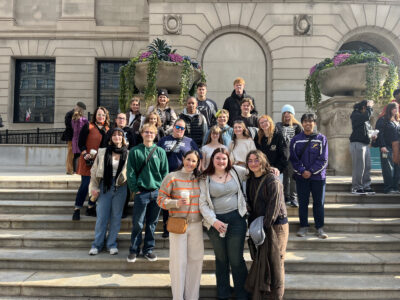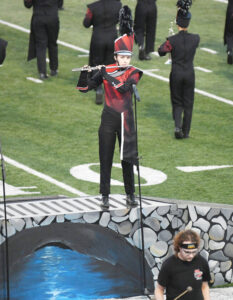Remembering heroic actions in tragedy
Bus trip teaches group about Spirit Lake Massacre
- -Messenger photo by Carol Foltz Carol Murphy, of Fort Dodge; her daughter Landra Carroll, of Manson; and her sister Paulette Harris, of Greene, stand in front of the plot where the Gardner family, Abbie Gardner-Sharp and her sons are buried. The three are descended from Henry Lott and Abbie Gardner.
- -Messenger photo by Carol Foltz A wreath was placed by the monument to the victims of the Spirit Lake Massacre and the members of the Spirit Lake Relief Expedition. Pictured from left are Bob Younie, a member of the Fort Dodge Historic Foundation; Lindsay McCormick-Welch, a member of the Wilson Brewer Historic Park Committee; and Bob Erickson, a member of the Wilson Brewer Historic Park Committee.
- -Messenger photo by Carol Foltz A flower arrangement was left at the Gardner family’s burial site. Pictured from left are Carolyn Miller, director of the Mulberry Center Church Museum; Esther Lehman, a staff member at the Wilson Brewer Historic Park and Museums; Veronica Guyader, executive director of the Fort Museum and Frontier Village; Cheryl Patrous, director of the Wilson Brewer Historic Park and Museums; and Jessica Einwalter, assistant curator and historical adviser of the Fort Museum and Frontier Village.

-Messenger photo by Carol Foltz Carol Murphy, of Fort Dodge; her daughter Landra Carroll, of Manson; and her sister Paulette Harris, of Greene, stand in front of the plot where the Gardner family, Abbie Gardner-Sharp and her sons are buried. The three are descended from Henry Lott and Abbie Gardner.
Dozens of people boarded a bus Saturday morning to travel 160 years into the past.
The trip was a collaboration between the Wilson Brewer Historic Park and Museums in Webster City and the Fort Museum and Frontier Village in Fort Dodge.
The Spirit Lake Massacre Remembrance Tour was a fundraiser for both institutions, and a new venture.
“This is the first time we’ve ever done this, so it was kind of a gamble,” said Veronica Guyader, executive director of the Fort Museum.
“I was pleasantly surprised at the interest in the subject matter,” she added, referring to the tragedy of the Spirit Lake Massacre.

-Messenger photo by Carol Foltz A wreath was placed by the monument to the victims of the Spirit Lake Massacre and the members of the Spirit Lake Relief Expedition. Pictured from left are Bob Younie, a member of the Fort Dodge Historic Foundation; Lindsay McCormick-Welch, a member of the Wilson Brewer Historic Park Committee; and Bob Erickson, a member of the Wilson Brewer Historic Park Committee.
•
For many, the story of the Spirit Lake Massacre begins about 10 years earlier, with Henry Lott.
Lott was settled near the mouth of the Boone River in 1846. He traded whiskey with the Indians and reportedly stole horses, sending them to Minnesota and Wisconsin. An Indian named Sidominadota ordered him to leave the land, but Lott refused.
Sidominadota’s band came back to raid Lott’s home, smashing beehives and breaking up property. Lott and his stepson fled. His wife and the other children were in the cabin and the Indians harrassed them. Milton Lott, 12, tried to find his father, but died of exposure and was found 20 miles downstream a few days later.
Mrs. Lott died a short time after the raid. Henry Lott was determined to seek revenge.

-Messenger photo by Carol Foltz A flower arrangement was left at the Gardner family’s burial site. Pictured from left are Carolyn Miller, director of the Mulberry Center Church Museum; Esther Lehman, a staff member at the Wilson Brewer Historic Park and Museums; Veronica Guyader, executive director of the Fort Museum and Frontier Village; Cheryl Patrous, director of the Wilson Brewer Historic Park and Museums; and Jessica Einwalter, assistant curator and historical adviser of the Fort Museum and Frontier Village.
He found his chance a few years later. In 1853, he tricked Sidominadota into going on an elk hunt with him. He shot Sidominadota and went back to his home, where he killed most of Sidominadota’s family, with the exception of a 10-year-old girl and older boy.
The bodies of the family were found about two weeks later. A group of Sioux Indians reported the murder to Maj. William Williams at Fort Dodge. They demanded action, expecting that the white settlers would hunt down Lott and bring him to justice.
A coroner’s inquest was held. Lott was indicted for the murders, but could not be found and no further action was taken.
The body of Sidominadota was brought to Homer, then the county seat, and his head was placed on a pole.
Sidominadota’s brother was Inkpaduta.
•
The winter of 1856-57 was harsh. Food was scarce for native Americans and white settlers. The two groups had distrust built up because of failed treaties and poor treatment on both sides. The Indians felt cheated of their lands and lifestyle. The settlers expected the Indians to change their ways and adopt their lifestyle.
A series of disastrous encounters between settlers and native Americans reached a climax in March 1857.
During March 8-12, 1857, a band of Sioux Indians led by Inkpaduta began attacking a small group of settlers around Okoboji and Spirit Lakes. Most of the settlers were killed, with the exception of three women and a teen — Abbie Gardner. Those four were forced to leave with the people who had killed their families.
When word of the massacre reached Fort Dodge and Webster City, men gathered for a relief expedition. They planned to bury the dead and try to catch up with and capture Inkpaduta’s band. Three companies were formed, totaling about 110 men.
The Webster City group made it to Fort Dodge in eight hours.
The Spirit Lake Relief Expedition left Fort Dodge on March 24, 1857.
The relief expedition traveled northward through high snowdrifts and swollen streams. They had no tents, only a blanket or buffalo robe to keep them warm at night.
When they had traveled about 80 miles, they met a group of about 20 settlers who had fled Springfield, Minnesota, after Inkpaduta’s band attacked there. The expedition’s members shared their food and an expedition scout accompanied the settlers to the Irish settlement, where Emmetsburg is today.
•
On April 1 at Granger’s Point — now Estherville — the relief expedition split into two units. Capt. J.C. Johnson led a company of 25 men to the massacre sites for burial detail. The rest of the relief expedition returned to the Irish settlement.
The burial took two days, as the ground was still frozen. On April 4, the group was ready to return to the Irish colony, but the men couldn’t agree on the route.
Some favored taking the route they had used to get there — through Granger’s Point. Others wanted to go directly across country. The group split, with 16 men taking the direct route and nine men — including Johnson and William Burkholder — retracing their steps.
The day had started out warm and foggy. By afternoon, a blizzard hit. Visibility was nearly nothing and it was easy to get disoriented. After hours of slogging through melting drifts, the men’s clothes were wet and when the temperature dropped, the clothes froze.
Johnson, Burkholder and a man named Smith were by themselves. Smith could see some trees that could provide shelter, but Johnson and Burkholder couldn’t move. Smith went on, knowing he could only save himself if he reached shelter.
Eleven years later, the skeletons of Johnson and Burkholder were found where they dropped. Burkholder’s remains were buried in Oakland Cemetery in Fort Dodge.
•
The rest of the men who had participated in the burial group made it back to the Irish settlement and the whole group headed home.
Their trials were not yet over. It had started raining and when the men reached Cylinder Creek, it was impassible. The temperature reached 32 degrees below zero. The men huddled together for warmth for 40 hours. When the ice on the creek froze enough, the men crossed.
•
The Spirit Lake Relief Expedition returned to Fort Dodge on April 10.
One of the relief expedition members, Cyrus Carpenter, who later became governor of Iowa, later said, “I have marched with armies engaged in actually war from Cairo to Chattanooga, but I have never experienced a conflict with the elements that could be compared with those two nights and one day on Cylinder Creek.”
•
Of the four captives taken by Inkpaduta’s band, only two survived. Margaret Marble and Abbie Gardner were ransomed separately to other groups of Indians, who brought them to Indian Agent Charles E. Flandreau. Lydia Noble and Elizabeth Thatcher had already been killed by members of Inkpaduta’s band.
Abbie Gardner returned to her home eventually, only to find that J.S. Prescott had taken possession of her father’s claim only about a month after the massacre. She had reunited with her sister Eliza, who had been in Springfield, Minnesota, at the time of the Spirit Lake Massacre. Eliza had married William Wilson. Abbie soon married Casville Sharp.
The Sharps had three children: Albert, Allen and Minnie. Their daughter died at about 18 months.
In 1891, Abbie returned to her old home and purchased the cabin. She set up a tourist spot, selling mementos and copies of the book she had written about the massacre.
In 1894, the state of Iowa erected a monument to those killed and to the members of the relief expedition.
Albert, Allen and Abbie are all buried in a small plot with the members of the Gardner family across the street from the cabin.
•
During the tour, each person was given a name of one of the people involved in the Spirit Lake Relief Expedition.
Narrators told the story of the relief expedition. Participants heard about the severe conditions suffered by the heroic volunteers who made the historic trip.
The trip went through Livermore, with a narrative stop at Lott’s Creek, Emmetsburg with a stop at the Palo Alto County Museum, the Gardner Cabin Monument in Arnolds Park, and the Grotto of the Redemption in West Bend.
Some of the participants are related to Henry Lott or Abbie Gardner. Three women — Carol Murphy, of Fort Dodge, her daughter Landra Carroll, of Manson, and her sister Paulette Harris, of Greene, are related to both of them.
In addition to the history lesson, participants received a bag of information and gifts from the Wilson Brewer Park and Museums and the Fort Museum and Frontier Village.








